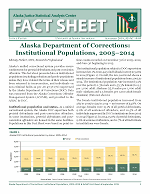AJiC Publications
Publications by year of publication
- 2023
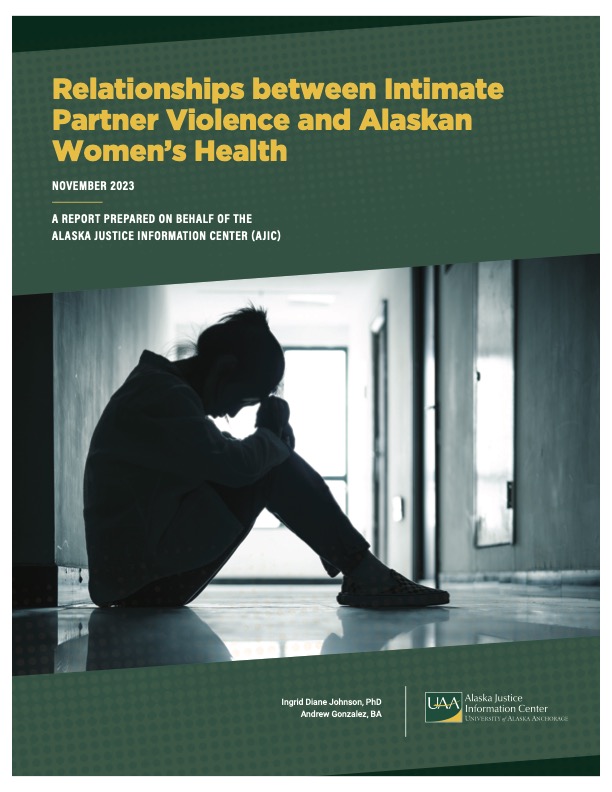 Relationships between Intimate Partner Violence and Alaskan Women's Health
Relationships between Intimate Partner Violence and Alaskan Women's HealthAJiC Report 2023-11 (November)
Ingrid Johnson & Andrew GonzalezThis report details a sample of Alaskan women's experiences with psychological, physical, and sexual harm by an intimate partner, and the relationships between those experiences and their current physical and mental health. These analyses of Alaska Victimization Survey (AVS) data are comprised of almost 13,000 survey responses from adult, non-institutionalized Alaskan women. The findings confirm those of prior, non-Alaska based research that all types of historical and recent intimate partner violence (IPV) are linked to victims’ current physical and mental health. Non-physical IPV has the same negative relationships with various health status indicators as physical IPV: Control, threats, and psychological aggression are generally associated with the same prevalence of negative health outcomes as physical violence, although sexual violence is associated with the highest prevalence of negative health outcomes. The AVS is conducted by the UAA Justice Center for the Council on Domestic Violence and Sexual Assault (CDVSA).
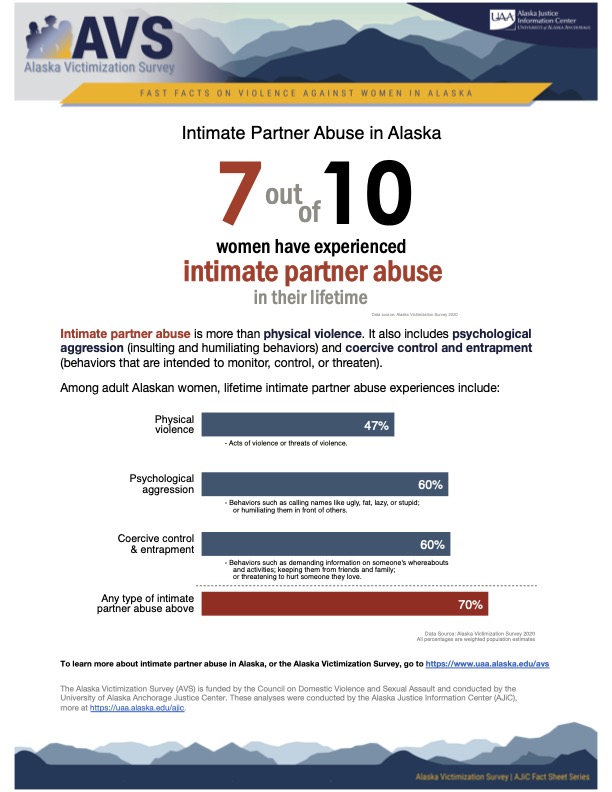 Fast Facts: Intimate Partner Violence in Alaska, 2020
Fast Facts: Intimate Partner Violence in Alaska, 2020 AJiC Fact Sheet 2023-10 (October)
Andrew Gonzalez & Ingrid JohnsonThis one-pager presents Alaska 2020 statewide estimates of intimate partner abuse using data from the Alaska Victimization Survey (AVS). The Alaska Victimization Survey is a collaboration between the UAA Justice Center and the Alaska Council on Domestic Violence and Sexual Assault.
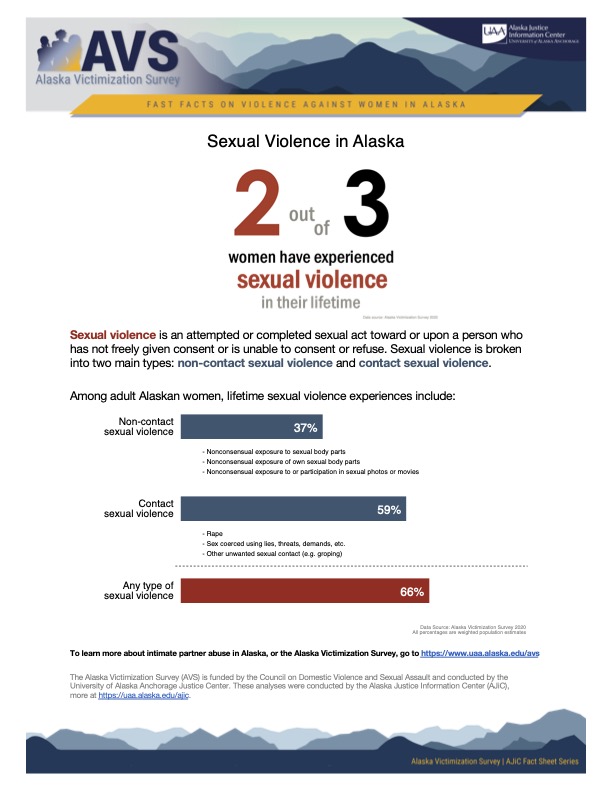 Fast Facts: Sexual Violence in Alaska, 2020
Fast Facts: Sexual Violence in Alaska, 2020AJiC Fact Sheet 2023-10 (October)
Andrew Gonzalez & Ingrid JohnsonThis one-pager presents Alaska 2020 statewide estimates of sexual violence using data from the Alaska Victimization Survey (AVS). The Alaska Victimization Survey is a collaboration between the UAA Justice Center and the Alaska Council on Domestic Violence and Sexual Assault.
- 2022
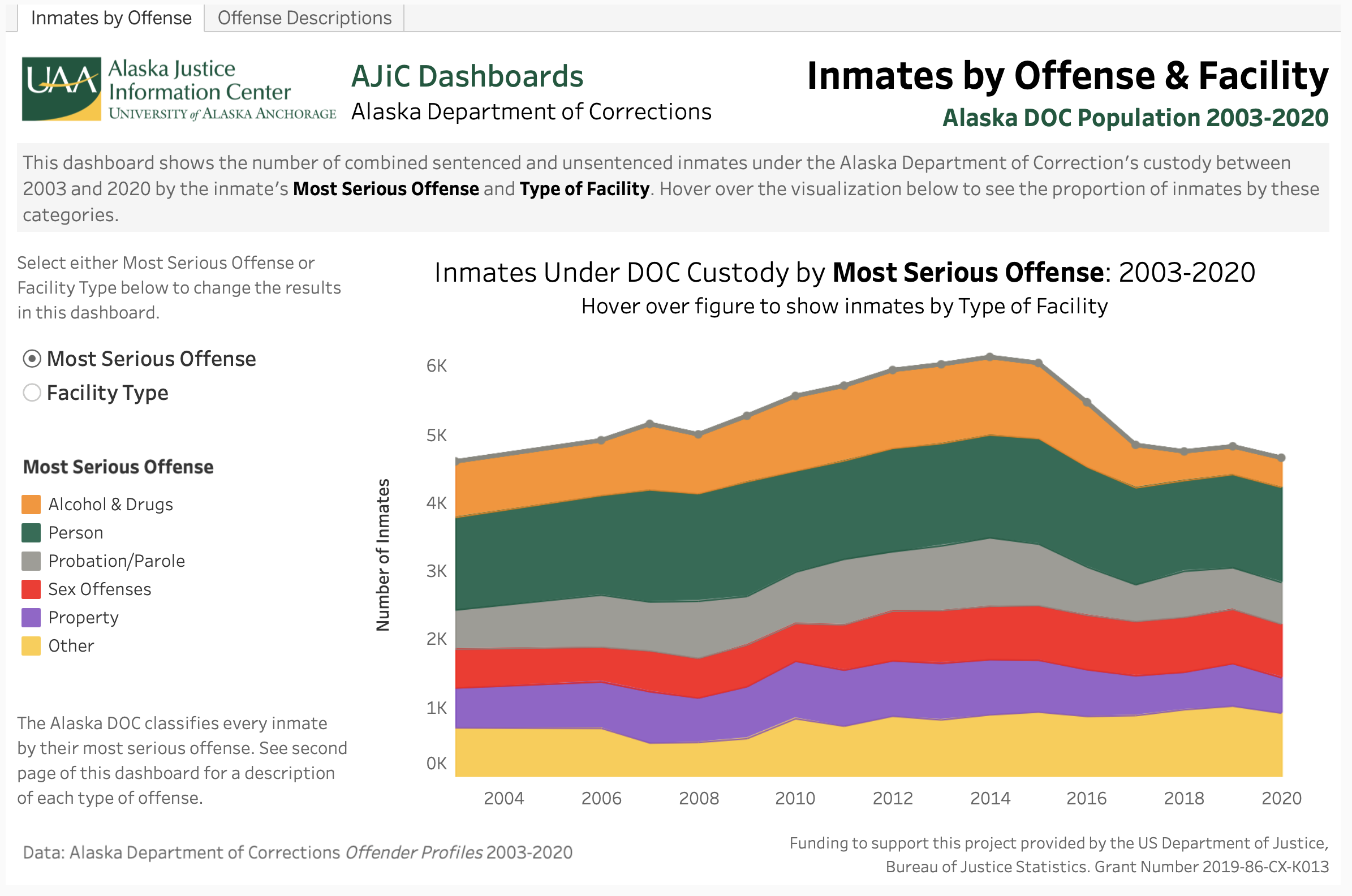 Alaska DOC Inmates by Offense & Facility Type Dashboard, 2003-2020
Alaska DOC Inmates by Offense & Facility Type Dashboard, 2003-2020AJiC Data Dashboard 2022-10 (October)
Andrew GonzalezThis interactive data dashboard describes the number of combined sentenced and unsentenced inmates under the Alaska Department of Correction's custody between 2003 and 2020. Users can view these counts by either most serious offense or the facility type. Data for this project are drawn from the Alaska DOC's Offender Profiles.
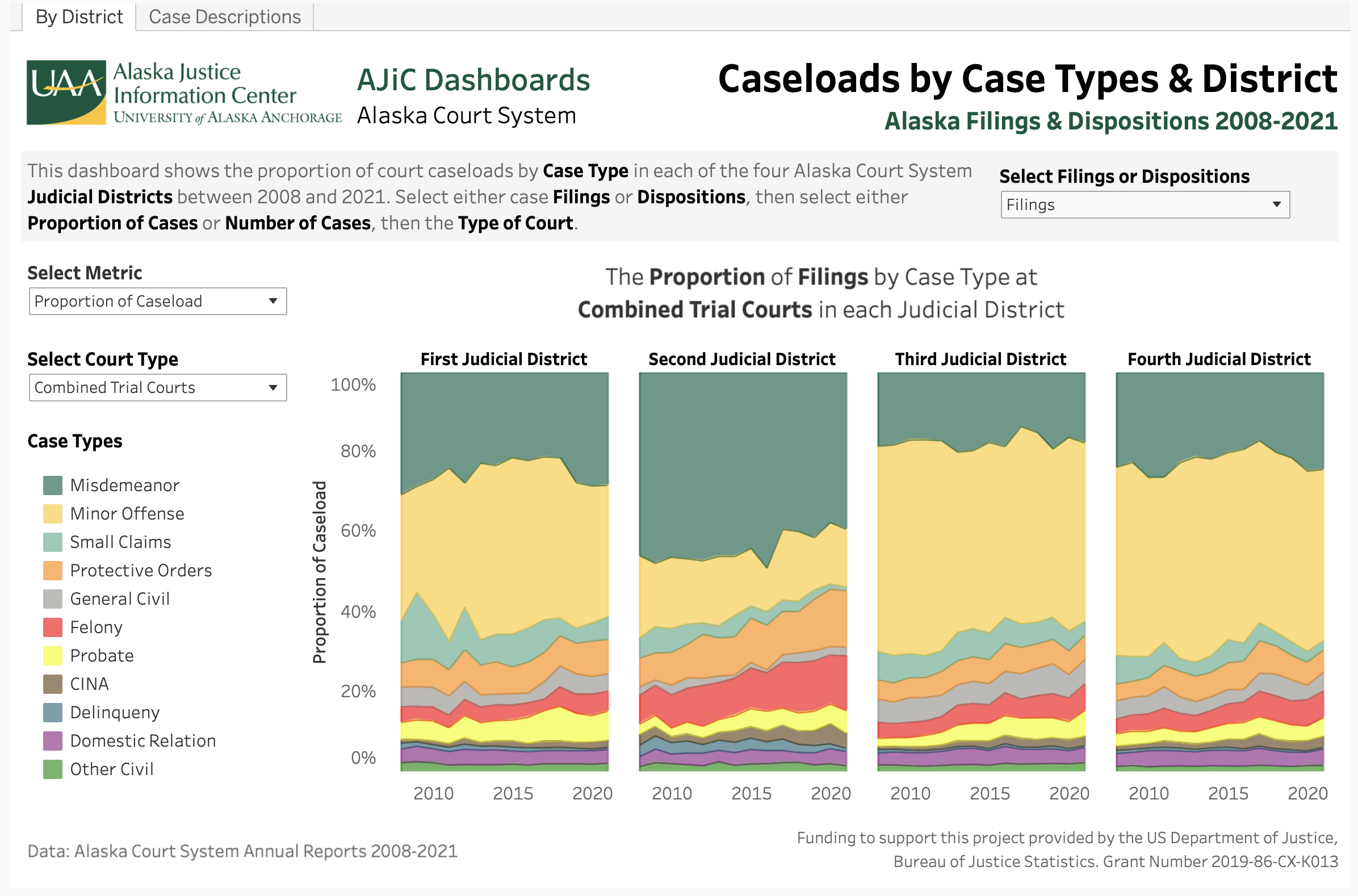 Alaska Caseloads by Case Type & Judicial District Dashboard, 2008-2021
Alaska Caseloads by Case Type & Judicial District Dashboard, 2008-2021AJiC Data Dashboard 2022-09 (September)
Andrew GonzalezThis interactive data dashboard describes the proportion of Alaska court caseloads by case type for each Alaska Court System Judicial District between 2008 and 2021. Users can select to view either case filings or case dispositions, and can view either the proportion of cases or number of cases within each judicial district. Data for this project are drawn for the Alaska Court System Annual Reports.
- 2021
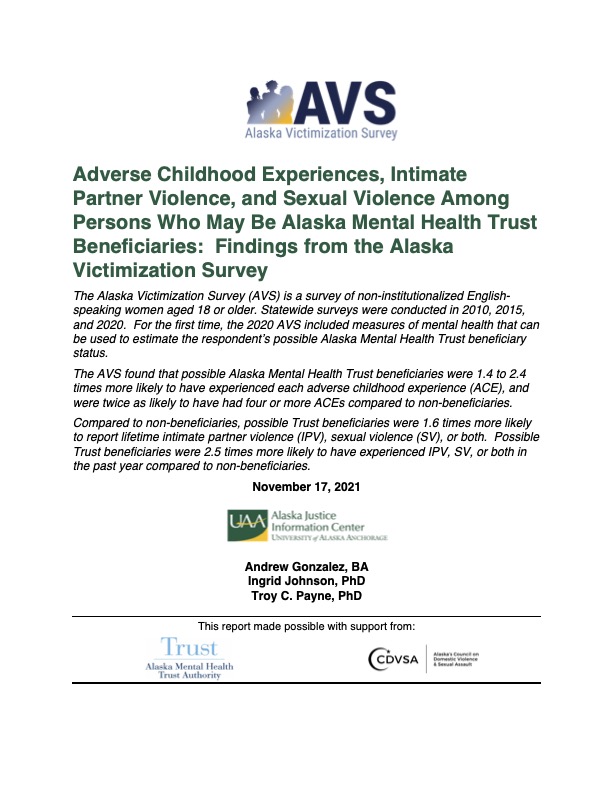 Adverse Childhood Experiences, Intimate Partner Violence, and Sexual Violence Among
Persons Who May Be Alaska Mental Health Trust Beneficiaries: Findings from the Alaska
Victimization Survey
Adverse Childhood Experiences, Intimate Partner Violence, and Sexual Violence Among
Persons Who May Be Alaska Mental Health Trust Beneficiaries: Findings from the Alaska
Victimization SurveyAJiC Report 2021-10 (October)
Andrew Gonzalez, Ingrid Johnson, & Troy C. PayneThe Alaska Justice Information Center (AJiC) at the University of Alaska Anchorage has released a new report, “Adverse Childhood Experiences, Intimate Partner Violence, and Sexual Violence Among Persons Who May Be Alaska Mental Health Trust Beneficiaries: Findings from the Alaska Victimization Survey.” This report used data from the 2020 Alaska Victimization Survey (AVS) to estimate the extent to which victims of intimate partner violence and sexual assault were possible Alaska Mental Health Trust beneficiaries. It also estimated the extent to which persons who may be Alaska Mental Health Trust beneficiaries experienced Adverse Childhood Experiences (ACEs). Alaska Mental Health Trust beneficiaries include Alaskans with mental illness, developmental disabilities, chronic alcohol or drug addiction, Alzheimer’s disease and related dementia, and traumatic brain injuries. The AVS is conducted by the UAA Justice Center for the Council on Domestic Violence and Sexual Assault (CDVSA).
 Intimate Partner Violence & Sexual Violence Among Women who may be Alaska Mental Health
Trust Beneficiaries Fact Sheet
Intimate Partner Violence & Sexual Violence Among Women who may be Alaska Mental Health
Trust Beneficiaries Fact SheetAJiC Fact Sheet 2021-10 (October)
Andrew Gonzalez, Ingrid Johnson, & Troy C. PayneA two-page Fact Sheet presenting data on the extent to persons who may be Alaska Mental Health Trust beneficiaries experienced intimate partner violence and sexual violence. It used data from the 2020 Alaska Victimization Survey (AVS). Alaska Mental Health Trust beneficiaries include Alaskans with mental illness, developmental disabilities, chronic alcohol or drug addiction, Alzheimer’s disease and related dementia, and traumatic brain injuries. The AVS is conducted by the UAA Justice Center for the Council on Domestic Violence and Sexual Assault (CDVSA).
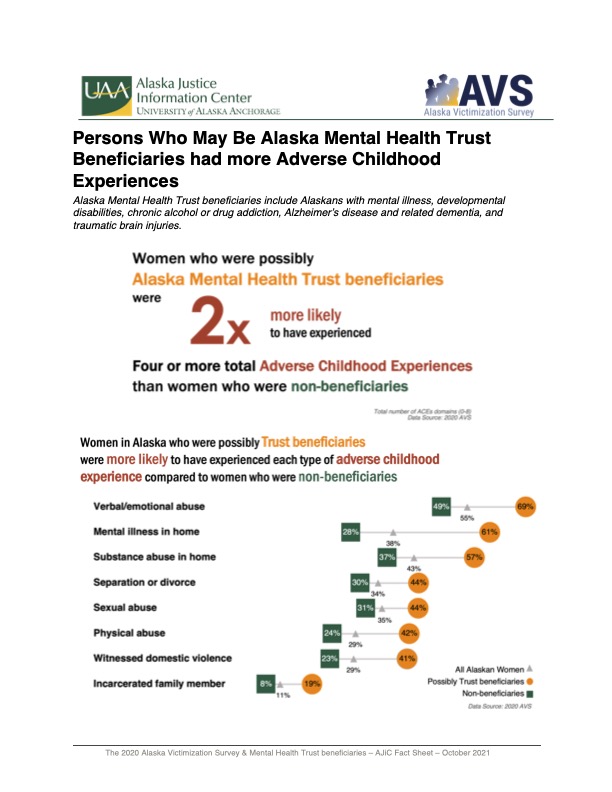 Adverse Childhood Experiences Among Women who may be Alaska Mental Health Trust Beneficiaries
Fact Sheet
Adverse Childhood Experiences Among Women who may be Alaska Mental Health Trust Beneficiaries
Fact SheetAJiC Fact Sheet 2021-10 (October)
Andrew Gonzalez, Ingrid Johnson, & Troy C. PayneA two-page Fact Sheet presenting data on the extent to persons who may be Alaska Mental Health Trust beneficiaries experienced Adverse Childhood Experiences (ACEs). It used data from the 2020 Alaska Victimization Survey (AVS). Alaska Mental Health Trust beneficiaries include Alaskans with mental illness, developmental disabilities, chronic alcohol or drug addiction, Alzheimer’s disease and related dementia, and traumatic brain injuries. The AVS is conducted by the UAA Justice Center for the Council on Domestic Violence and Sexual Assault (CDVSA).
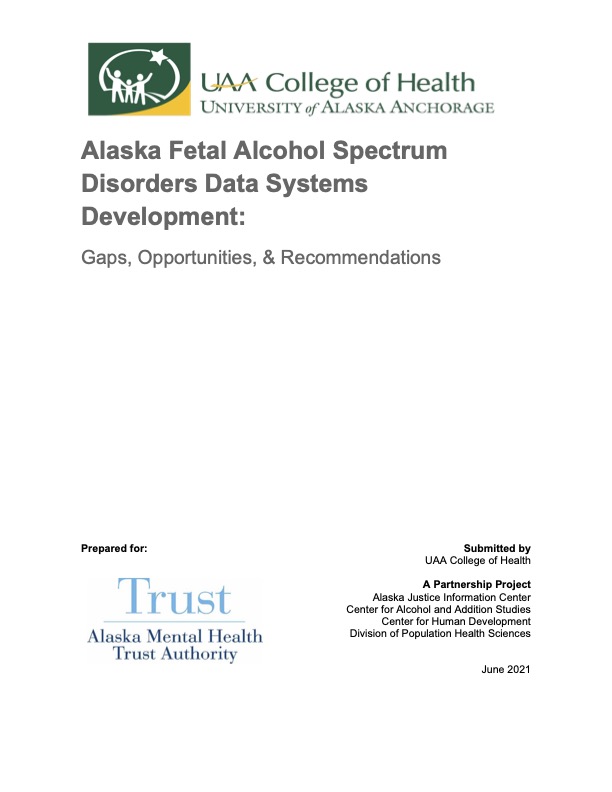 Alaska Fetal Alcohol Spectrum Disorders Data Systems Development: Gaps, Opportunities,
& Recommendations
Alaska Fetal Alcohol Spectrum Disorders Data Systems Development: Gaps, Opportunities,
& RecommendationsAJiC Collaboration with COH 2021-06 (June)
Troy C. Payne, Yevgenii Kisarauskas, Avram Slone, & Andrew Gonzalez; Other COH colleaguesThe report, "Alaska Fetal Alcohol Spectrum Disorders Data Systems Development," was prepared for the Alaska Mental Health Trust Authority by the University of Alaska Anchorage (UAA) College of Health. This report was a partnership between the Alaska Justice Information Center, the Center for Alcohol and Addiction Studies, the Center for Human Development, and the Division of Population Health Sciences.
 Alaska Police Officer Use of Deadly Force: 2010-2020
Alaska Police Officer Use of Deadly Force: 2010-2020AJiC Report 2021-04 (April)
Troy C. Payne, Yevgenii Kisarauskas, & Robert E. HendersonThe Alaska Justice Information Center (AJiC) at the University of Alaska Anchorage has released Alaska Police Officer Use of Deadly Force: 2010-2020, a new report that compiles 11 years of casefiles from the Alaska Department of Law Office of Special Prosecutions (OSP) involving police officer use of deadly force from 2010 to October 2020, covering a total of 92 incidents, 100 citizens, and 295 officers. Until recently, little data existed regarding police use of deadly force. The FBI's National Use-of-Force data collection only began accepting data in 2019. This is the first time Alaska-specific data have been compiled and examined across a multi-year timespan—representing a valuable new resource for data-informed decision-making.
- 2020
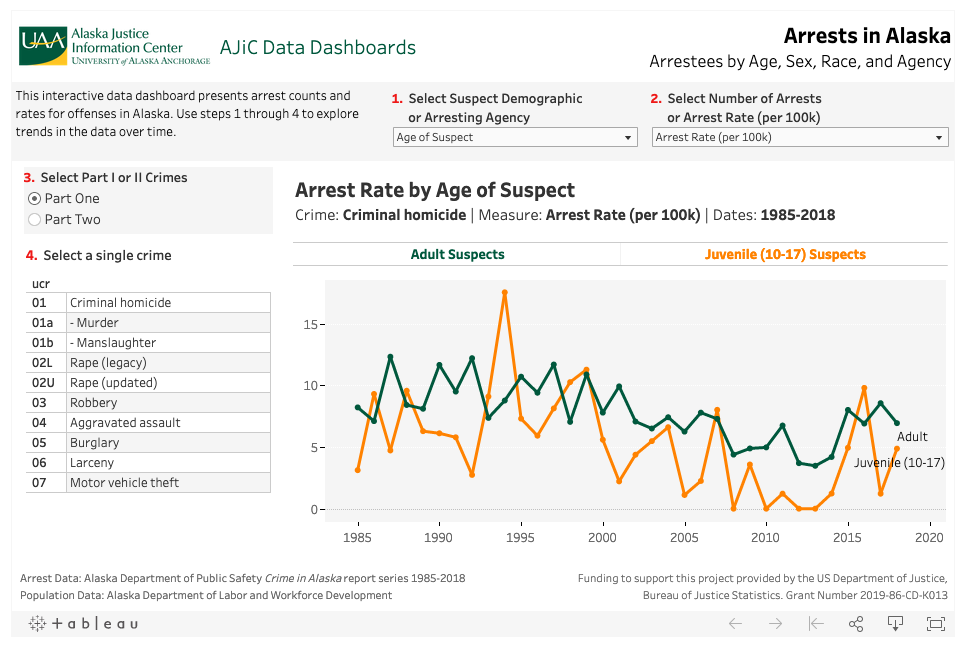 Arrests in Alaska Dashboard, 1985-2018
Arrests in Alaska Dashboard, 1985-2018AJiC Data Dashboard 2020-11 (November)
Andrew Gonzalez & Avram SloneThis interactive data dashboard describes the rate and count of arrests made in the state of Alaska between 1985 and 2018. Users can filter arrests by crime, then present data over time by the age, race, or sex of the suspect. Data for this project are drawn from the Alaska Department of Public Safety's Crime in Alaska report series and from the Alaska Department of Labor and Workforce Development's population estimates.
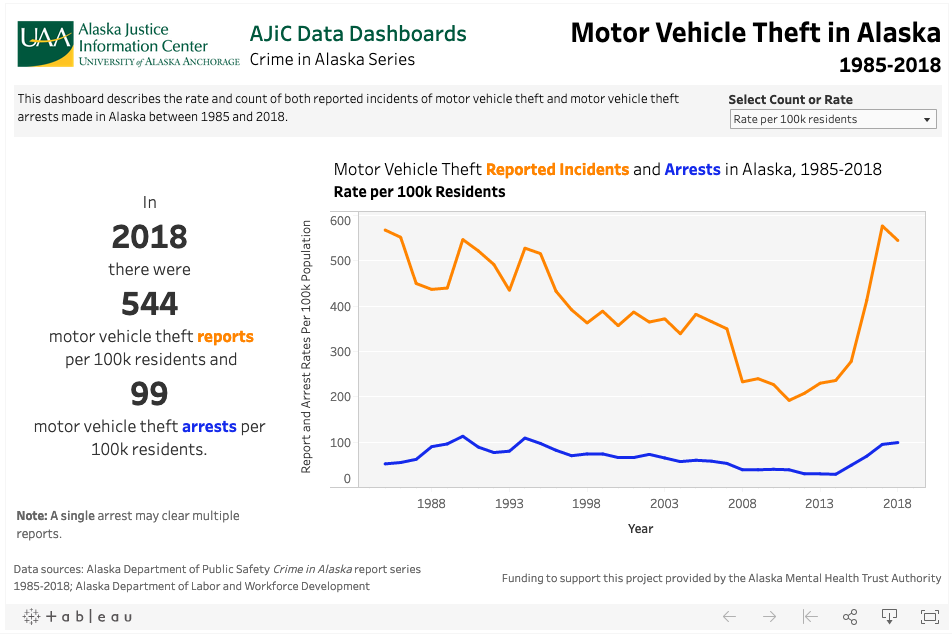 Motor Vehicle Theft Dashboard
Motor Vehicle Theft DashboardAJiC Data Dashboard 2020-10 (October)
Avram SloneThis interactive data dashboard describes the rate and count of reported incidents of motor vehicle theft as well as motor vehicle theft arrests made in the state of Alaska between 1985 and 2018. Data for this project are drawn from the Alaska Department of Public Safety's Crime in Alaska report series and from the Alaska Department of Labor and Workforce Development's population estimates.
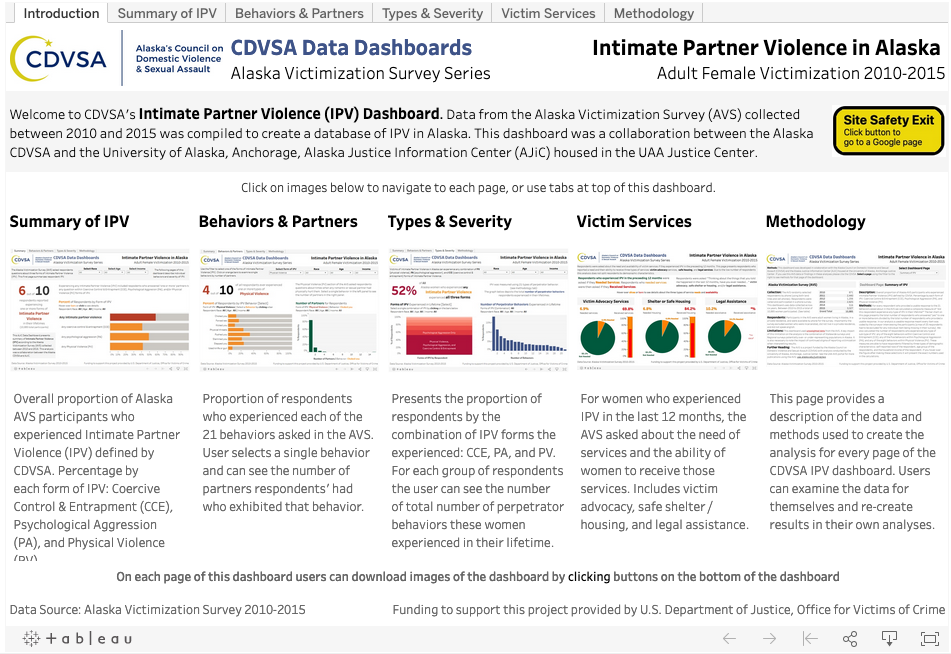 Intimate Partner Violence - Interactive Data Dashboard (IPV-IDD)
Intimate Partner Violence - Interactive Data Dashboard (IPV-IDD)AJiC Data Dashboard 2020-10 (October)
Andrew GonzalezAn interactive data dashboard providing users with customizable visualizations of Alaska's intimate partner violence (IPV) patterns. The IPV-IDD focuses on physical violence, coercive control and entrapment, and psychological aggression. It used data from the Alaska Victimization Survey from 2010-2015. The Alaska Victimization Survey is a collaboration between the UAA Justice Center and the Alaska Council on Domestic Violence and Sexual Assault.
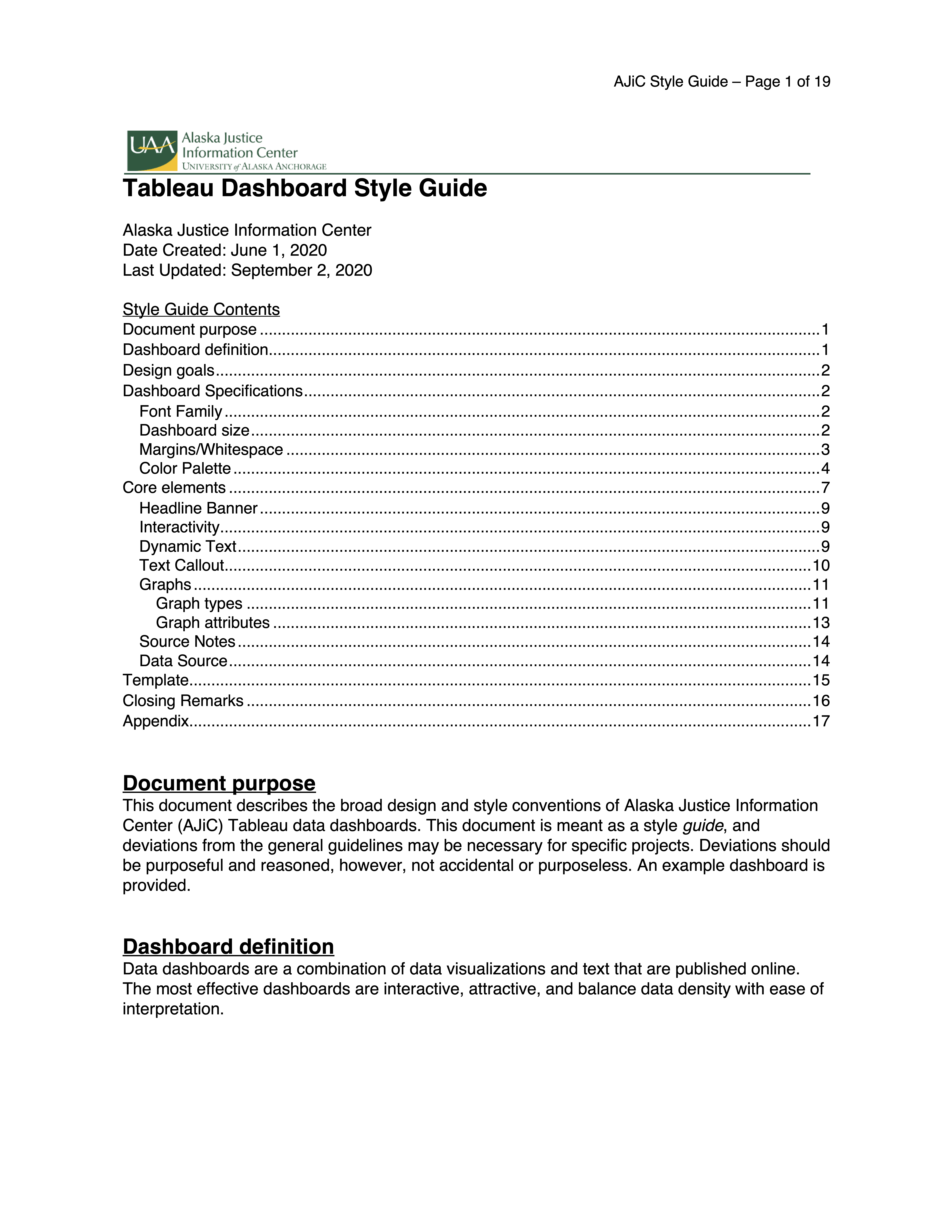 AJiC Tableau Dashboard Style Guide
AJiC Tableau Dashboard Style GuideAJiC Report 2020-09 (September)
Alaska Justice Information StaffThis document describes the broad design and style conventions of Alaska Justice Information Center (AJiC) Tableau data dashboards. This document is meant as a style guide, and deviations from the general guidelines may be necessary for specific projects. Design goals and styles for every part of a dashboard are presented in the document.
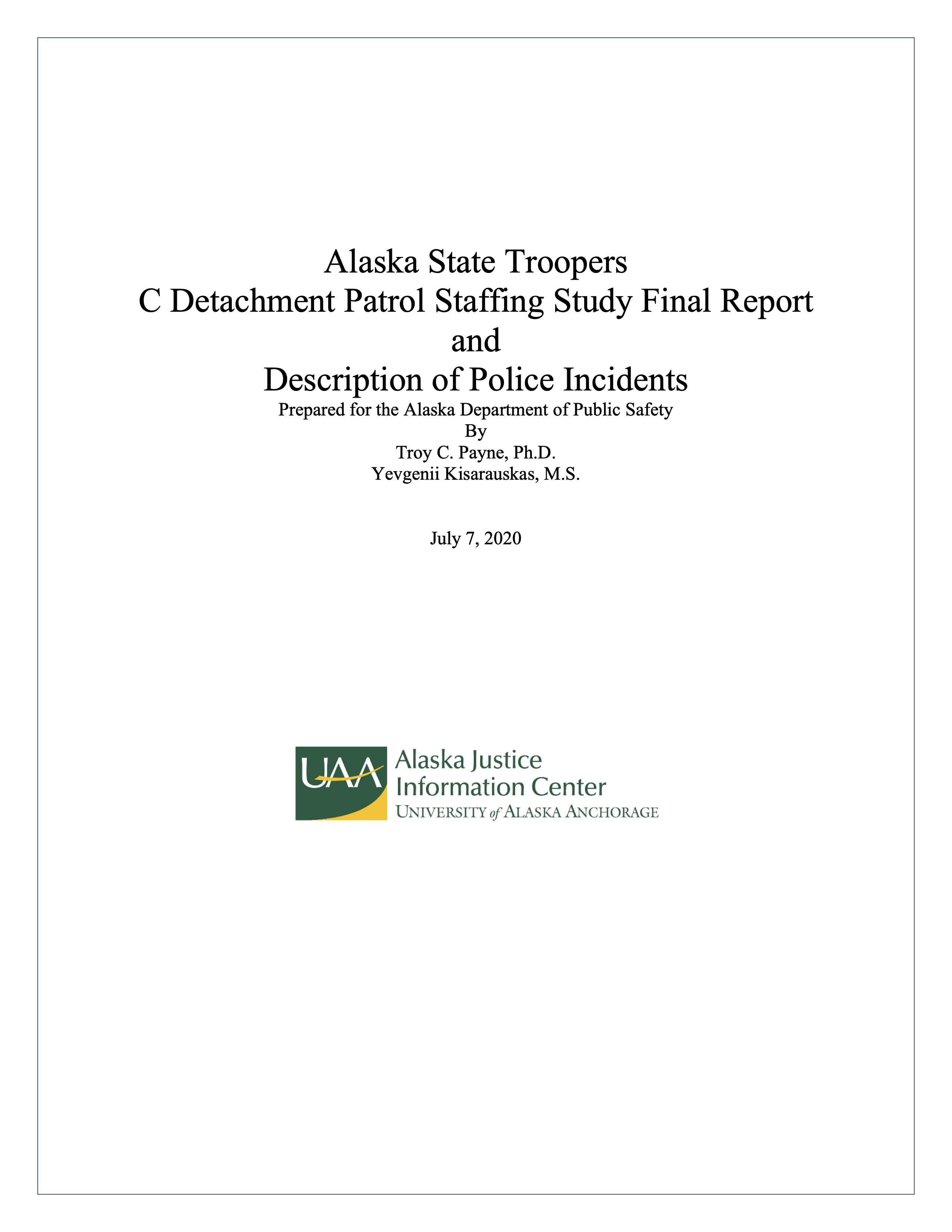 Alaska State Trooper C Detachment Patrol Staffing Study Final Report and Description
of Police Incidents
Alaska State Trooper C Detachment Patrol Staffing Study Final Report and Description
of Police IncidentsAJiC Report 2020-07 (July)
Troy C. Payne & Yevgenii KisarauskasThis report provides a workload-based staffing estimate for the Alaska State Troopers C Detachment sworn staff, including troopers and court service officers. The report begins by examining incidents serviced by C Detachment for meaningful changes over years, seasonal variation, and variation by incident type. Next, we describe challenges of creating a workload- based model for staffing C Detachment, followed by summaries of interviews with sergeants in C Detachment and a description of C Detachment’s stated goals. The model is specified next, including a post-by-post staffing recommendation for C Detachment based on the 75th percentile of the number of reports, adjusted for leave and other factors.
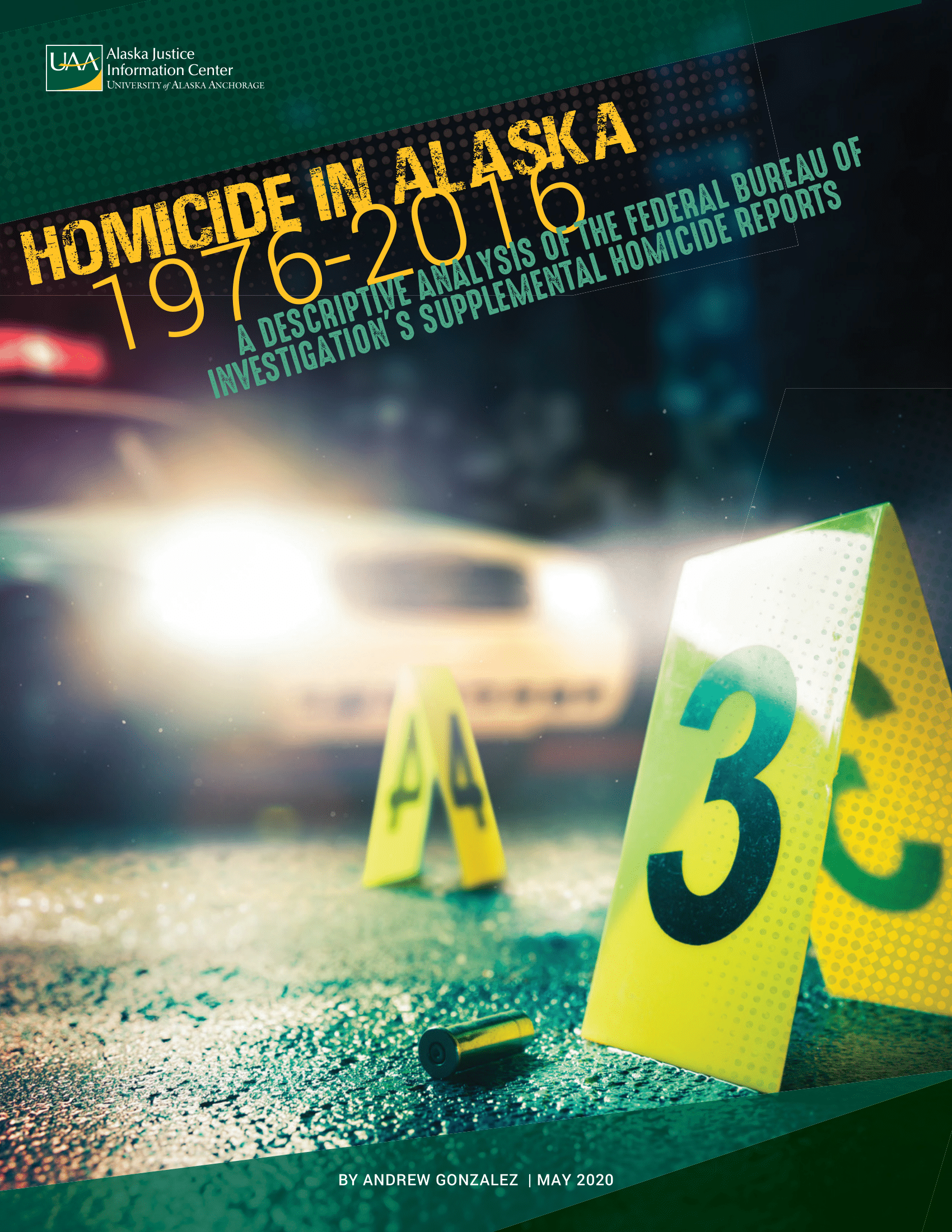 Homicide in Alaska: 1976-2016
Homicide in Alaska: 1976-2016AJiC Report 2020-05 (May)
Andrew GonzalezHomicide in Alaska: 1976-2016, compiles 41 years of data from the Supplementary Homicide Report (SHR). This is the first time these data on homicide in Alaska have been examined across a multi-year timespan. The 68-page report presents a description of how homicides differ by race and sex. This allows for an analysis of American Indian and Alaska Native female homicide victims by comparison. Additionally, it presents homicide victimization (victims per 100,000 residents) by race and sex of the victim. See Homicide in Alaska for the full suite of homicide reports created by AJiC.
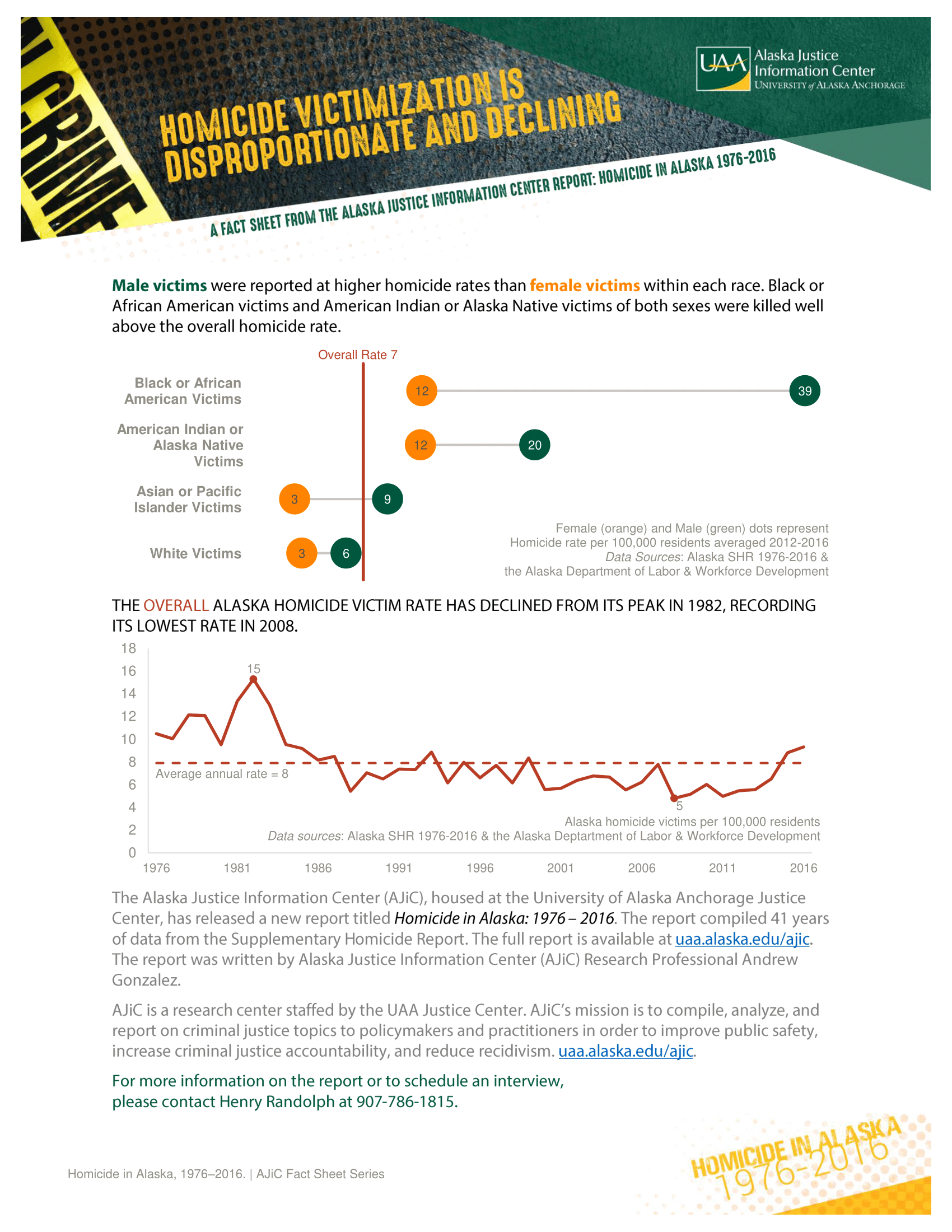 Victimization Homicide Fact Sheet
Victimization Homicide Fact SheetAJiC Fact Sheet 2020-05 (May)
Andrew GonzalezA single page Fact Sheet presenting data on Alaska Homicide victimization. Shows the homicide victims per 100,000 Alaska residents by the race and sex combination of the victim. Presents the number of total homicide victims per 100,000 Alaska residents between 1976 and 2016. See Homicide in Alaska for the full suite of homicide reports created by AJiC.
 Firearm Homicide Fact Sheet
Firearm Homicide Fact SheetAJiC Fact Sheet 2020-05 (May)
Andrew GonzalezA single page Fact Sheet presenting data on firearm use in Alaska homicide. Shows the percent of Alaska Homicide Victims killed by a firearm. Presents how firearm use varies among homicide victims by unique race and sex combination. See Homicide in Alaska for the full suite of homicide reports created by AJiC.
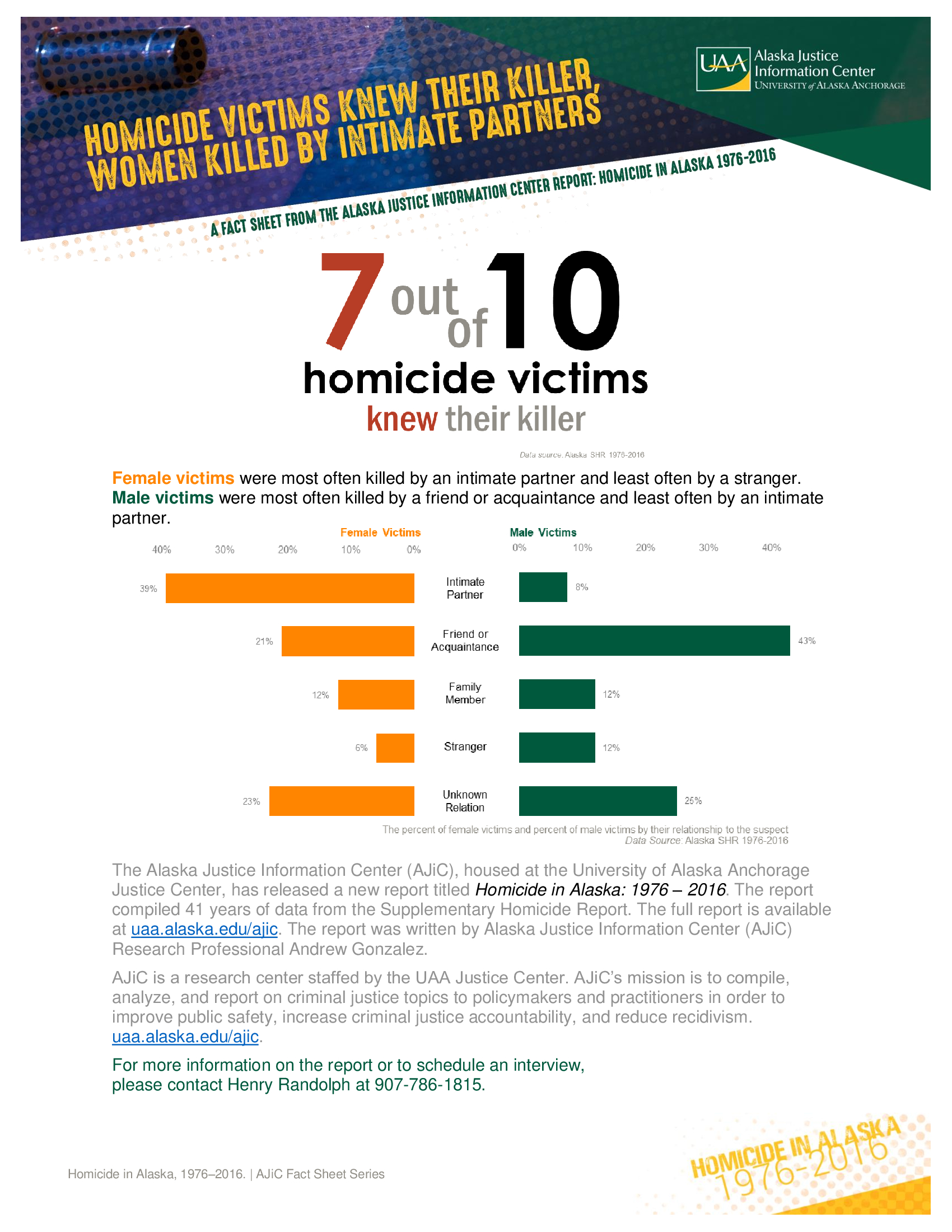 Relationship Homicide Fact Sheet
Relationship Homicide Fact SheetAJiC Fact Sheet 2020-05 (May)
Andrew GonzalezA single page Fact Sheet presenting key findings on the relationship between homicide victim and offende. The proportion of homicide victims who knew their killer. How the relationship between victim and suspect was different between female victims and male victims. See Homicide in Alaska for the full suite of homicide reports created by AJiC.
 Homicide Victim Relationship Dashboard
Homicide Victim Relationship DashboardAJiC Data Dashboard 20-05 (May)
Andrew GonzalezAn interactive data dashboard showing the percent of Alaska Homicide Victims by their relationship to the Homicide Suspect. The percent of victims by their relationship to the suspect separated by the sex of the victim. The user can filter by the Race and Age of the victim to examine different victim demographic combinations. See Homicide in Alaska for the full suite of homicide reports created by AJiC.
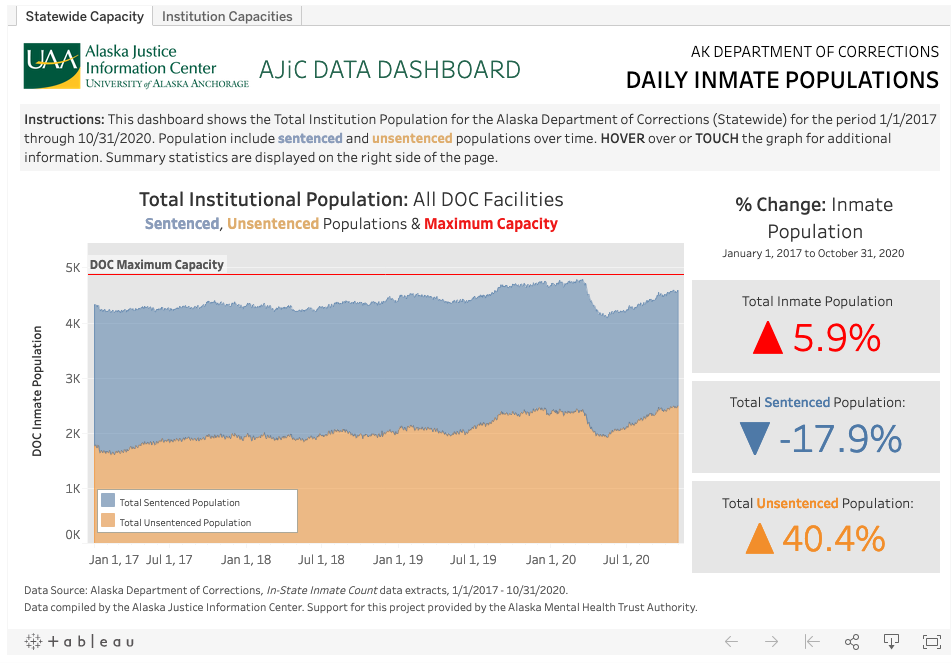 Daily Inmate Populations Alaska DOC Dashboard
Daily Inmate Populations Alaska DOC DashboardAJiC Data Dashboard 2020-02 (February)
Andrew Gonzalez & Brad A. MyrstolThis interactive data dashboard presents daily inmate populations for each of the Alaska Department of Corrections’ thirteen in-state facilities. It includes data for sentenced and unsentenced populations provided by DOC “In-State Inmate Count” data extracts. Data begins January 1, 2017 and is updated with new data monthly. Find the dashboard at uaa.alaska.edu/ajic/dashboards/docpop
- 2019
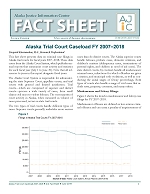 Alaska Trial Court Caseload FY 2007–2018
Alaska Trial Court Caseload FY 2007–2018AJiC Fact Sheet 2019-02 (June) [Download data for AJiC Fact Sheet 19-02]
Yevgenii KisarauskasPresents data on criminal case filings in Alaska trial courts for fiscal years 2007–2018. From FY07 to FY18, misdemeanors filed in Alaska trial courts decreased while felonies filed increased. The majority of the increase in total felony filings came from violent, property, and weapons cases. The majority of the decline in district court cases is due to declining filings in public order, DUI, and other motor vehicle cases.
 Property Crime in Alaska 1985–2017
Property Crime in Alaska 1985–2017AJiC Fact Sheet 2019-01 (March) [Download data for AJiC Fact Sheet 19-01]
Yevgenii KisarauskasDescribes Alaska property crime trends from 1985 through 2017, with a focus on motor vehicle theft rate trends. Overall property crime in Alaska increased by 28.6% from 2011 to 2017. Burglary and larceny theft increased moderately, but motor vehicle theft rates tripled from the lowest recorded rate 2011 to the highest recorded rate in 2017.
- 2018
 Drug Possession Arrests Reported in Alaska, 1986–2017 — Drug Types by Sex
Drug Possession Arrests Reported in Alaska, 1986–2017 — Drug Types by SexAJiC Fact Sheet 2018-07 (December) [Download data for AJiC Fact Sheet 18-07]
Benjamin ErvinPresents data on drug sale and manufacture arrests by type of drug and sex of arrestee as reported by Alaska law enforcement agencies for the 32-year period 1986 to 2017. Types of drugs include narcotics, synthetic narcotics, marijuana, and other non-narcotic drugs.
 Drug Sale and Manufacture Arrests Reported in Alaska, 1986–2017 — Drug Types by Sex
Drug Sale and Manufacture Arrests Reported in Alaska, 1986–2017 — Drug Types by SexAJiC Fact Sheet 2018-06 (December) [Download data for AJiC Fact Sheet 18-06]
Benjamin ErvinPresents data on drug possession arrests by type of drug and sex of arrestee as reported by Alaska law enforcement agencies for the 32-year period 1986 to 2017. Types of drugs include narcotics, synthetic narcotics, marijuana, and other non-narcotic drugs.

Drug Possession Arrests Reported in Alaska, 1986–2017
AJiC Fact Sheet 2018-05 (September) [Download data for AJiC Fact Sheet 18-05]
Benjamin ErvinPresents data on drug sale possession arrests reported by Alaska law enforcement agencies for the 32-year period 1986 to 2017 for Alaska overall, by gender, and by age.
 Drug Sale and Manufacture Arrests Reported in Alaska, 1986–2017
Drug Sale and Manufacture Arrests Reported in Alaska, 1986–2017AJiC Fact Sheet 18-04 (September) [Download data for AJiC Fact Sheet 18-04]
Benjamin ErvinPresents data on drug sale and manufacture arrests reported by Alaska law enforcement agencies for the 32-year period 1986 to 2017 for Alaska overall, by gender, and by age.
 Drug Cases Filed across the Alaska Court System, FY 2008–2017
Drug Cases Filed across the Alaska Court System, FY 2008–2017AJiC Fact Sheet 2018-03 (August) [Download data for AJiC Fact Sheet 18-03]
Daniel ReinhardPresents data on drug-related court filings throughout the state of Alaska for fiscal years (FY) 2008 through 2017 and the 10-year trend of misdemeanor and felony drug case filings for Alaska and for the Anchorage, Palmer, Kenai and Fairbanks courts over the same period.
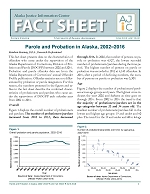 Parole and Probation in Alaska, 2002–2016
Parole and Probation in Alaska, 2002–2016AJiC Fact Sheet 2018-02 (June) [Download data for AJiC Fact Sheet 18-02]
Random ReameyPresents data on the value of stolen property reported in Alaska from 1985 to 2016 as reported in the Department of Public Safety publication Crime in Alaska. Overall, the 31-year trend reveals that the total value of stolen property in Alaska was relatively static with a trough beginning in 2008 and rising in 2014. The increase in stolen property value from 2014 to 2016 was mainly due to increases in the aggregate values of stolen motor vehicles and miscellaneous items.
 Value of Stolen Property Reported in Alaska, 1985–2016
Value of Stolen Property Reported in Alaska, 1985–2016AJiC Fact Sheet 2018-01 (January) [Download data for AJiC Fact Sheet 18-01]
Random ReameyPresents data on the value of stolen property reported in Alaska from 1985 to 2016 as reported in the Department of Public Safety publication Crime in Alaska. Overall, the 31-year trend reveals that the total value of stolen property in Alaska was relatively static with a trough beginning in 2008 and rising in 2014. The increase in stolen property value from 2014 to 2016 was mainly due to increases in the aggregate values of stolen motor vehicles and miscellaneous items.
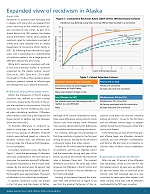 Expanded View of Recidivism in Alaska
Expanded View of Recidivism in AlaskaAlaska Justice Forum 34(3), Winter 2018
Araceli ValleThis article describes findings on recidivism over an eight-year period for individuals released from Alaska Department of Corrections facilities in 2007. These findings emerged from the report Alaska Results First Initiative released by AJiC in October 2017. In general, the Results First findings corroborate previous analyses which examined recidivism patterns one to three years after release, but by following offenders for eight years, AJiC is expanding our understanding of recidivism patterns in Alaska for a large group of offenders, beyond any prior study.
- 2017
 Motor Vehicle Theft Arrests Reported in Alaska, 1986–2015
Motor Vehicle Theft Arrests Reported in Alaska, 1986–2015AJiC Fact Sheet 17-03 (Dec 2017) [Download data for AJiC Fact Sheet 17-03]
Random ReameyPresents data on motor vehicle theft arrests reported in Alaska from 1985 to 2016 as reported in the Alaska Department of Public Safety publication Crime in Alaska. Overall, the motor vehicle arrest rate consistently declined between 1990 and 2014 when it reached the lowest level in the 1985–2016 period. The motor vehicle arrest rate rebounded in 2015 and 2016. Increases in Alaska motor vehicle arrest rates in 2015 and 2016 were particularly pronounced among adults and males, while motor vehicle arrest rates for juveniles and females remained minimal in comparison.
 Alaska Results First Initiative: Adult Criminal Justice Program Benefit Cost Analysis
Alaska Results First Initiative: Adult Criminal Justice Program Benefit Cost AnalysisAJiC Report (Oct 2017)
Araceli ValleThe Alaska Results First Initiative, a new report from the Alaska Justice Informaton Center (AJiC) at the Justice Center, shows that most of Alaska's evidence-based adult criminal justice programs are showing positive return on state investment of money. Notably, all but one of those programs are shown to measurably reduce recidivism (the likelihood that an inmate will re-offend when released), which not only improves public safety, but saves the state the costs associated with criminal activity.
 Violent Crime Reported in Alaska, 1986-2015
Violent Crime Reported in Alaska, 1986-2015AJSAC Fact Sheet 17-02 (Feb 2017) [Download data for AJSAC Fact Sheet 17-02]
Khristy ParkerPresents data on violent crimes reported in Alaska from 1986 to 2015 as reported in the Alaska Department of Public Safety publication Crime in Alaska. "Violent crime" is an aggregate category that includes homicide (murder and non-negligent manslaughter), rape, robbery, and aggravated assault offenses reported to police. From 1986 to 2015, violent crime rates increased in Alaska although the overall crime rate decreased.
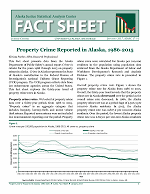 Property Crime Reported in Alaska, 1986-2015
Property Crime Reported in Alaska, 1986-2015AJSAC Fact Sheet 17-01(Jan 2017) [Download data for AJSAC Fact Sheet 17-01]
Khristy ParkerPresents data on property crime in Alaska from 1986 to 2015 as reported in the Alaska Department of Public Safety publication Crime in Alaska. "Property crime" is an aggregate category that includes burglary, larceny-theft, and motor vehicle theft crimes. From 1986 to 2015 the property crime rate in Alaska decreased as the overall crime rate decreased. On average, property crime accounted for two-thirds of all crime in Alaska over the thirty-year period.
- 2016
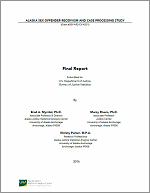 Alaska Sex Offender Recidivism and Case Processing Study: Final Report
Alaska Sex Offender Recidivism and Case Processing Study: Final ReportAJSAC Report (Dec 2016)
Brad A. Myrstol, Marny Rivera, & Khristy ParkerThis report provides updated estimates of Alaska sex offender recidivism, expanding the post-inarceration follow-up period from two years (as used in previous studies) to seven years in order to better understand sex offender desistance from crime; and analyzes data on individuals arrested at least once for the commission of one or more registerable sex offenses from 2008 to 2011 to evaluate the accuracy and completeness of Alaska’s criminal history repository data on sex offenses and to explore the quality of those data for examining case processing of misdemeanor and felony offenses.
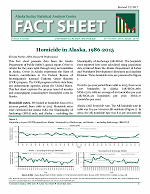 Homicide in Alaska, 1986-2015
Homicide in Alaska, 1986-2015AJSAC Fact Sheet 16-06 (Nov 2016; revised 2/1/17) [Download data for AJSAC Fact Sheet 16-06]
Khristy ParkerPresents data reported on homicides (murders and nonnegligent manslaughters) in Alaska from 1986 to 2015 as reported in the Alaska Department of Public Safety publication Crime in Alaska. Over the 30-year period from 1986 to 2015, homicide rates decreased in Alaska overall, but increased in the Municipality of Anchorage. The Fact Sheet also presents data on the most commonly used weapons in homicides, victim-offender relationships, and clearance rates for homicides.
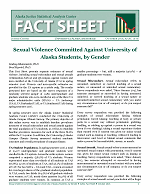 Sexual Violence Committed Against University of Alaska Students, by Gender
Sexual Violence Committed Against University of Alaska Students, by GenderAJSAC Fact Sheet 16-05 (Oct 2016)
Lindsey Blumenstein & Brad MyrstolPresents past year estimates of sexual misconduct and sexual assault victimization against University of Alaska (UA) students both on and off campus. Women- and men-specific estimates are provided for the UA system as a whole only. The results presented here are based on the survey responses of a randomly selected sample of 1,982 undergraduate and graduate students who were enrolled at any of the three UA major administrative units (MAUs) — UA Anchorage (UAA), UA Fairbanks (UAF), or UA Southeast (UAS) during spring semester 2016 This survey was modeled on the Campus Climate Survey Recommendations prepared by the White House Task Force to Protect Students from Sexual Assault.
 Sexual Misconduct and Sexual Assault Committed Against University of Alaska Students
Sexual Misconduct and Sexual Assault Committed Against University of Alaska StudentsAJSAC Fact Sheet 16-04 (Jun 2016; revised 10/20/16)
Lindsey Blumenstein & Brad MyrstolPresents past year estimates of sexual misconduct and sexual assault victimization against University of Alaska (UA) students. Estimates are provided for the UA system as a whole, as well as for each of UA's three major administrative units (MAUs): the University of Alaska Anchorage (UAA), the University of Alaska Fairbanks (UAF), and the University of Alaska Southeast (UAS). This survey was modeled on the Campus Climate Survey Recommendations prepared by the White House Task Force to Protect Students from Sexual Assault.
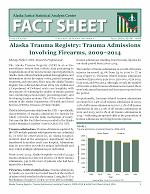 Alaska Trauma Registry: Trauma Admissions Involving Firearms, 2009–2014
Alaska Trauma Registry: Trauma Admissions Involving Firearms, 2009–2014AJSAC Fact Sheet 16-03 (Apr 2016)
Khristy ParkerPresents data on the characteristics of trauma admissions resulting from the use of a firearm in Alaska for the period 2009 through 2014.
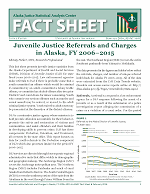 Juvenile Justice Referrals and Charges in Alaska, FY 2006-2015
Juvenile Justice Referrals and Charges in Alaska, FY 2006-2015AJSAC Fact Sheet 16-02 (Feb 2016)
Khristy ParkerPresents data on the number of referrals and charges, and unique individuals referred to the Alaska Division of Juvenile Justice (DJJ) during FY 2006–2015.
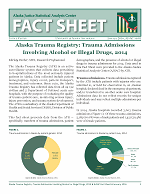 PDF of Alaska Trauma Registry: Trauma Admissions Involving Alcohol or Illegal Drugs,
2014
PDF of Alaska Trauma Registry: Trauma Admissions Involving Alcohol or Illegal Drugs,
2014AJSAC Fact Sheet 16-01 (Jan 2016)
Khristy ParkerPresents data on trauma admissions to Alaska hospitals in 2014. The Fact Sheet focuses on demographics of patients with trauma admissions, as well as the number of trauma admissions involving alcohol or illegal drugs.
- 2015
 Alaska Department of Corrections: Post-conviction Incarcerated Population, 2005-2014
Alaska Department of Corrections: Post-conviction Incarcerated Population, 2005-2014AJSAC Fact Sheet 15-04 (Oct 2015)
Khristy ParkerPresents data on post-conviction incarcerated populations in the Alaska Department of Corrections (DOC) from 2005–2014. The Fact Sheet focuses on post-conviction incarcerated populations by crime classifications and crime categories overall and within gender.
Alaska Department of Corrections: Institutional Populations, 2005-2014
AJSAC Fact Sheet 15-03 (Sep 2015)
Khristy ParkerPresents data on institutional populations in the Alaska Department of Corrections (DOC) from 2005-2014, focusing on pretrial and post-conviction populations and rates, by gender. Probation, parole, and non-criminal hold (as per AS 47.37.170) populations are excluded from this report.
 Descriptive Analysis of Domestic Violence and Sexual Assault Incidents Closed by the
Alaska State Troopers: 2008–2011 — Final Report
Descriptive Analysis of Domestic Violence and Sexual Assault Incidents Closed by the
Alaska State Troopers: 2008–2011 — Final Report AJSAC Report (Jul 2015)
Brad A. Myrstol & Khristy ParkerThis report presents a descriptive analysis of sexual assault and domestic violence incidents closed by the Alaska State Troopers for the period January 1, 2008 through December 31, 2011, as part of an effort to systematically document the formal processing of sexual assault (SA), sexual abuse of a minor (SAM), and domestic violence incidents reported to law enforcement agencies in Alaska.
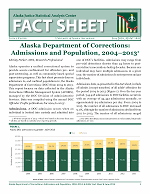 Alaska Department of Corrections: Admissions and Population, 2004–2013
Alaska Department of Corrections: Admissions and Population, 2004–2013AJSAC Fact Sheet 15-02 (Jun 2015)
Khristy ParkerPresents data on admissions to, and confined populations in, the Alaska Department of Corrections (DOC) from 2004-2013, focusing on incarcerated populations and rates, in both in-state and out-of-state facilities, as well as populations and rates in special supervision programs such as Community Residential Centers (CRCs) and electronic monitoring (EM).
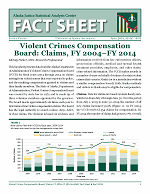 Violent Crimes Compensation Board Claims: FY 2004–FY 2014
Violent Crimes Compensation Board Claims: FY 2004–FY 2014AJSAC Fact Sheet 15-01 (Apr 2015)
Khristy ParkerPresents data from the Alaska Violent Crimes Compensation Board (VCCB) on claims made and compensation granted to victims of violent crime for state fiscal years 2004–2014. The fact sheet presents data on new claims filed, types of crimes and types of expenses for which compensation was granted, and compensation totals (adjusted to 2014 U.S. dollars).
- 2014
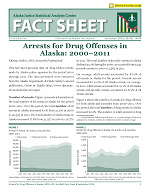 Arrests for Drug Offenses in Alaska: 2000–2011
Arrests for Drug Offenses in Alaska: 2000–2011AJSAC Fact Sheet 14-03 (Sep 2014; revised 19 Sep 2014)
Khristy ParkerPresents data for 2000–2011 on arrests for drug offenses made by Alaska police agencies. The fact sheet presents drug offense arrest information for both adults and juveniles, including number of drug offense arrests, drug offense arrests as a percentage of all arrests, drug offense arrest rate, and drug offense types.
REVISION NOTE: This fact sheet was revised following notification from Alaska Department of Public Safety (DPS) of incomplete data reported for 2012 in Crime in Alaska. This notification precipitated the exclusion of 2012 data from the fact sheet. The title of this fact sheet has changed to reflect the change in data used.
 State and Local Law Enforcement Personnel in Alaska: 1982–2012
State and Local Law Enforcement Personnel in Alaska: 1982–2012AJSAC Fact Sheet 14-02 (Aug 2014)
Khristy ParkerPresents data for 1982–2012 on state and local law enforcement personnel in Alaska, includingsize of law enforcement agencies by number of employed personnel, police-citizen ratio, ratio of sworn officers to civilian employees, and employment of women as sworn officers.
 Burglary in Alaska: 1985–2012
Burglary in Alaska: 1985–2012AJSAC Fact Sheet 14-01 (Jul 2014)
Khristy ParkerPresents data for 1985–2012 on the property crime of burglary, including burglary rates, time and place of occurrence, and the value of property stolen during burglaries reported to police.
- 2013
 Arrests for Violent Crimes in Alaska, 1980-2012
Arrests for Violent Crimes in Alaska, 1980-2012
AJSAC Fact Sheet 13-12 (Dec 2013)
This fact sheet has been removed from the website. The Alaska Justice Statistical Analysis Center (AJSAC) has been informed by the Alaska Department of Public Safety (DPS) that the UCR arrest data that had been published in Crime in Alaska (2012) were incorrect due to incomplete data submissions for 2012. DPS has since made note of these data issues in the Crime in Alaska (2012) publication.
 Firearm Use in Violent Crime in the U.S. and Alaska, 1985–2012
Firearm Use in Violent Crime in the U.S. and Alaska, 1985–2012AJSAC Fact Sheet 13-11 (Nov 2013)
Khristy ParkerPresents national and statewide statistics from the FBI's Uniform Crime Reports program on the use of firearms in the commission of three violent crimes — homicide (murder and nonnegligent manslaughter), robbery, and aggravated assault — in the U.S. and Alaska from 1985 to 2012. Data on the use of knives and other cutting instruments, strong-arm tactics, and other weapons in the commission of these crimes are also presented.
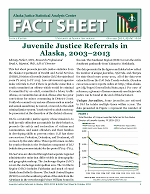 Juvenile Justice Referrals in Alaska, 2003–2013
Juvenile Justice Referrals in Alaska, 2003–2013AJSAC Fact Sheet 13-10 (Oct 2013)
Khristy Parker & Brad A. MyrstolPresents juvenile justice statistics from the Alaska Department of Health and Social Services (DHSS), Division of Juvenile Justice (DJJ) for state fiscal years FY 2003 to FY 2013. The data presented includes the number of unique juveniles referred to DJJ, referrals made to DJJ by law enforcement, charges by class and offense type, and demographic data of juveniles in the system. This report focuses on the Probation component of DJJ (which also processes intake) for the period FY03-FY13.
 Arrests for Drug Offenses in Alaska: 2000–2011
Arrests for Drug Offenses in Alaska: 2000–2011AJSAC Fact Sheet 13-09 (Sep 2013)
Brad A. MyrstolPresents data on arrests for drug offenses made by Alaska police agencies for the period 2000 through 2011. The report presents drug offense arrest information for both adults and juveniles for the 12-year period, including number of drug offense arrests, drug offense arrests as a percentage of all arrests, drug offense arrest rate, and drug offense types.
 DUI/DWI Arrests in Alaska: 2000–2011
DUI/DWI Arrests in Alaska: 2000–2011AJSAC Fact Sheet 13-08 (Aug 2013)
Brad A. MyrstolPresents data on driving under the influence (DUI) and driving while intoxicated (DWI) arrests made by Alaska police agencies for the period 2000 through 2011. The report describes overall rates ofarrest for DUI/DWI during the 12-year period, as well as DUI/DWI arrest rates by major law enforcement agency, by sex, and by race.
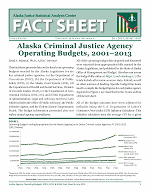 Alaska Criminal Justice Agency Operating Budgets, 2001–2013
Alaska Criminal Justice Agency Operating Budgets, 2001–2013AJSAC Fact Sheet 13-07 (Jul 2013)
Brad A. MyrstolPresents data on operating budgets enacted by the Alaska Legislature for six key criminal justice agencies from state fiscal years 2001 to 2013. These agencies include the Department of Corrections, Department of Public Safety, Alaska Court System, Division of Juvenile Justice, Criminal Divison of the Department of Law, and Legal and Advocacy Services within the Department of Administration (including the Office of Public Advocacy, the Public Defender Agency, and the Violent Crimes Compensation Board).
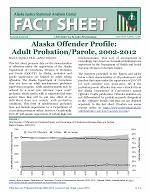 Alaska Offender Profile: Adult Probation/Parole, 2002–2012
Alaska Offender Profile: Adult Probation/Parole, 2002–2012AJSAC Fact Sheet 13-06 (Jun 2013)
Brad A. MyrstolPresents data on the adult probation/parole population under Alaska Department of Corrections supervision for the period 2002–2012, and briefly describes how probation and parole operate in Alaska.
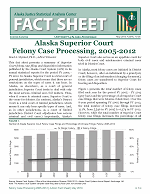 Alaska Superior Court Felony Case Processing, 2005–2012
Alaska Superior Court Felony Case Processing, 2005–2012AJSAC Fact Sheet 13-05 (May 2013)
Brad A. MyrstolExamines the composition of felony case filings (person, property, drug, or "other" cases) in Alaska Superior Courts and the final disposition of felony cases.
 Alaska Trial Court Case Filing Statistics, 2005–2012
Alaska Trial Court Case Filing Statistics, 2005–2012AJSAC Fact Sheet 13-04 (Apr 2013)
Brad A. Myrstol & Ryan FortsonPresents data on cases filed in Alaska's trial courts (Superior Court and District Court) during state fiscal years 2005–2012. Data were extracted from Alaska Court System annual statistical reports. The report examines data on case filings, caseloads, and types of cases filed in Superior and District courts.
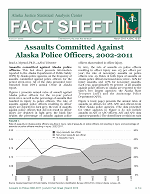 Assaults Committed Against Alaska Police Officers, 2002–2011
Assaults Committed Against Alaska Police Officers, 2002–2011AJSAC Fact Sheet 13-03 (Mar 2013)
Brad A. MyrstolExamines data on assaults on police and officers killed in the line of duty (1960–2011).
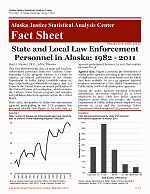 State and Local Law Enforcement Personnel in Alaska: 1982–2011
State and Local Law Enforcement Personnel in Alaska: 1982–2011AJSAC Fact Sheet 13-02 (Feb 2013)
Brad A. MyrstolThis report looks at the number of sworn police officers and civilian employees in law enforcement agencies in Alaska, the ratio of sworn police officers to civilian employees, the numberof female sworn police officers in law enforcement, and presents comparisons with national data.
 Violent Crime Arrests in Alaska
Violent Crime Arrests in AlaskaAJSAC Fact Sheet 13-01 (Jan 2013)
Brad A. MyrstolPresented in this Fact Sheet are violent crime arrest data for the period 1980–2011. The data were extracted from the Alaska Department of Public Safety's annual report Crime in Alaska. Arresttrend data for Part I violent crimes (murder/non-negligent homicide, forcible rape, robbery, aggravated assault) are presented in the aggregate and for each offense category. Age, sex, and racial group membership information for those arrested by Alaska law enforcement in 2011 are also presented.
- 2012
 Firearm Use in Violent Crime in the U.S. and Alaska, 1980–2011
Firearm Use in Violent Crime in the U.S. and Alaska, 1980–2011AJSAC Fact Sheet 12-01 (Dec 2012)
Brad A. MyrstolPresented in this Fact Sheet issue are national and statewide statistics on the prevalence of murder in the U.S. and Alaska from 1980 to 2011, as well as data on the use of firearms in murders (both for the U.S. as a whole, and Alaska), aggravated assaults (Alaska only), and robberies (Alaska only) over the same period.










